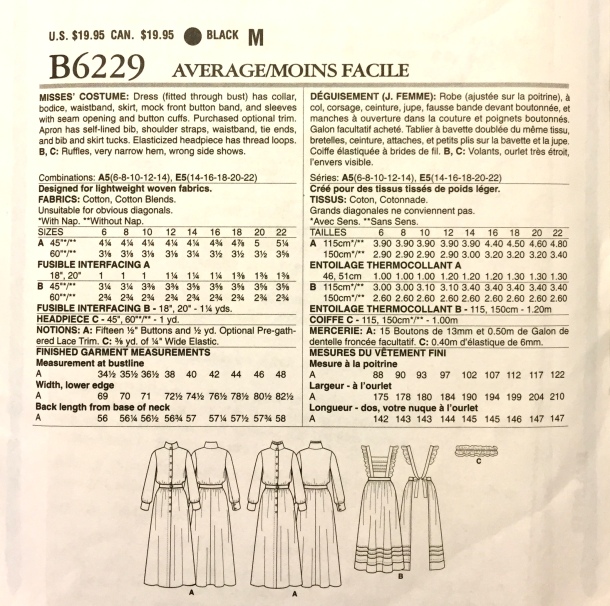My old wrist injury is acting up, so I have to take a little break from hand-sewing, but since I have a few of the eyelets done, I thought this would be a good time to show how I do them.
This is not necessarily the historically correct way, but the method I find to be sturdy and aesthetically pleasing.
Punching a hole through the fabric weakens it, so I use an awl to poke a small hole, which I widen with a pointed chopstick. I then insert an eyelet through the widened hole, and then use a table-top eyelet/grommet press to set it in place. Finally, I sew over the eyelet with a button hole stitch to make it pretty.
The picture below, from right to left shows:
- Mark the hole with a pencil.
- Poke the hole with an awl.
- Widen the hole with a chopstick.
- Insert the eyelet from the wrong side (explained below).
- The eyelet set in by the eyelet press.

The eyelet is inserted from the lining side, with the flange remaining inside the stays. This results in the outside having a smaller surface area for you to wrap with thread. (If you are making a corset where the metal eyelets will show, you will insert the eyelet in the opposite direction, from the fashion fabric side).
Here is a view from the other side. From left to right you have the widened hole, the eyelet inserted, and the eyelet after being pressed. (There is some puckering in my fabric because I sewed the channels a little too tight for the double reed boning).
 I use a Homepro eyelet setter with a size 6 die. It is quite heavy, and very easy to use. I have trouble applying enough pressure with hand-held eyelet pliers, and find using a hammer awkward, so this is a handy thing to have.
I use a Homepro eyelet setter with a size 6 die. It is quite heavy, and very easy to use. I have trouble applying enough pressure with hand-held eyelet pliers, and find using a hammer awkward, so this is a handy thing to have.
 Use a tight blanket stitch over the eyelet to give it a finished appearance. You can use embroidery thread, or sewing thread. I used the latter, folding over a length of thread before threading the needle, resulting in a cluster of 4 threads each time. You can also just cast over with your thread, which is faster than using a blanket stitch, but I prefer the look of the latter.
Use a tight blanket stitch over the eyelet to give it a finished appearance. You can use embroidery thread, or sewing thread. I used the latter, folding over a length of thread before threading the needle, resulting in a cluster of 4 threads each time. You can also just cast over with your thread, which is faster than using a blanket stitch, but I prefer the look of the latter.
 See parts 1 and 2 and 3 and 4.
See parts 1 and 2 and 3 and 4.

 I couldn’t find a lightweight wool I liked so I ordered some black Kaufman Kona cotton from Fabric.com. My order came with this cute sticker on it!
I couldn’t find a lightweight wool I liked so I ordered some black Kaufman Kona cotton from Fabric.com. My order came with this cute sticker on it! I ended up with an extra half yard for free! I also bough white cotton broadcloth for the apron. It was a very bright white, so I ended up tea-dyeing it, then washing it in Oxiclean to get rid of the excess color. It still appears white, but no longer looks so stark next to the antique laces I am using. The fabric on the right is my broacloth, next to some pure white fabric voile for comparison.
I ended up with an extra half yard for free! I also bough white cotton broadcloth for the apron. It was a very bright white, so I ended up tea-dyeing it, then washing it in Oxiclean to get rid of the excess color. It still appears white, but no longer looks so stark next to the antique laces I am using. The fabric on the right is my broacloth, next to some pure white fabric voile for comparison.  I purchased a group of 20s and 30s lace trims from Etsy, that I will be using on the apron bodice, the maid’s cap, and the collar and cuffs of the dress. If there is enough I might use it on the hem of the apron, since I really dislike doing pintucks.
I purchased a group of 20s and 30s lace trims from Etsy, that I will be using on the apron bodice, the maid’s cap, and the collar and cuffs of the dress. If there is enough I might use it on the hem of the apron, since I really dislike doing pintucks.



 I hope this will be a very comfortable day time outfit for Costume College!
I hope this will be a very comfortable day time outfit for Costume College!





























